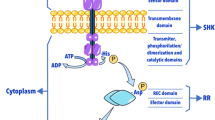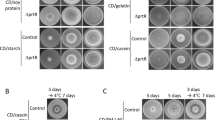Summary
It is shown that mutants of Saccharomyces cerevisiae able to efficiently utilise exogenous dTMP can also utilise exogenous dAMP. Under extracellular conditions permissive for dTMP uptake label stemming from offered [8-3H]dAMP is incorporated preferentially into alkali-resistant, high molecular weight material (putative DNA): only about 30% of high molecular weight cell-bound dAMP label was found to be sensitive towards mild alkali hydrolysis. This putative RNA label can be minimised to practically zero when ≧mM Ade is employed in a dAMP labelling assay. Exogenous dAMP at ≫10 μM was found to be cytostatic similarly to ≫μM dTMP and similarly to inhibit effectively import of exogenous Pi. We conclude from our results that there exists a yeast cytoplasmic membrane permease able to import dAMP. A model of this hypothetical permease system is presented.
Similar content being viewed by others
Abbreviations
- S. cerevisiae :
-
Saccharomyces cerevisiae
- TIP :
-
yeast cytoplasmic membrane permease importing dTMP under permisive conditions
- AIP :
-
hypothetical yeast cytoplasmic membrane permease importing dAMP under permissive conditions
- tlr :
-
symbol for the recessive genetic trait to utilise effeciently exogenous dTMP
- tmp :
-
symbol for the recessive genetic trait leading to dTMP auxotrophy
- dTMP:
-
2′-deoxythymidine 5′-monophosphate
- dAMP:
-
2′-deoxyadenosine 5′-monophosphate
- (d)NMP:
-
(deoxy)ribonucleoside 5′-monophosphate
- dThd:
-
2′-deoxythymidine
- Thy:
-
thymine
- dAdo:
-
2′-deoxyadenosine
- Ado:
-
adenosine
- Ade:
-
adenine
- Ura:
-
uracil
- Pi :
-
inorganic phosphate
References
Brendel M, Fäth WW, Laskowski W (1975) Isolation and characterization of mutants of Saccharomyces cerevisiae able to grow after inhibition of dTMP synthesis. In: Prescott DM (ed) Methods in cell biology, Vol 11. Academic Press Inc, New York San Francisco London, pp 287–294
Cohen GN, Monod J (1957) Bacterial permeases. Bacteriol Rev 21:169–194
Fäth WW, Brendel M (1974) Specific DNA-labelling by exogenous thymidine 5′-monophosphate in Saccharomyces cerevisiae. Mol Gen Genet 131:57–67
Fäth WW, Brendel M, Laskowski W, Lehmann-Brauns E (1974) Economizing DNA-specific labelling by exogenous deoxythymidine 5′-monophosphate in Saccharomyces cerevisiae. Mol Gen Genet 132:335–345
Fäth WW, Brendel M (1975a) An improved assay of UV-induced thymine-containing dimers in Saccharomyces cerevisiae. Z Naturforsch 30c:804–810
Fäth WW, Brendel M (1975b) UV-induction of thymine-containing dimers in Saccharomyces cerevisiae. Z Naturforsch 30c:811–817
Fäth WW, Brendel M (1976) Isolation and properties of yeast mutants with highly efficient thymidylate utilization. Z Naturforsch 31c:468–478
Fäth WW, Majid Q, Hartmann EM, Brendel M (1982) Nucleic acid metabolism in yeast. III. Identification of the dTMP-uptaking principle as a cytoplasmic membrane permease. (submitted for publication)
Fäth WW, Brendel M (1982a) Nucleic acid metabolism in yeast. IV. A clue to the physiological function of the cytoplasmic membrane permease importing exogenous dTMP. (submitted for publication)
Fäth WW, Brendel M (1982b) Nucleic acid metabolism in yeast. V. Excretion of thymidylate. Mol Gen Genet 188:115–120
Harold FM (1966) Inorganic polyphosphate in biology: Structure, metabolism, and function. Bacteriol Rev 30:772–794
Hartman SC (1970) Purines and pyrimidines. In: Greenberg DM (ed) Metabolic pathways, Vol 4. Academic Press, New York London, pp 1–68
Jung C, Rothstein A (1965) Arsenate uptake and release in relation to the inhibition of transport and glycolysis in yeast. Biochem Pharmacol 14:1093–1112
Langjahr UG, Hartmann EM, Brendel M (1975) Nucleic acid metabolis in yeast. I. Inhibition of RNA and DNA biosynthesis by high concentrations of exogenous deoxythymidine 5′-monophosphate in 5′-dTMP low requiring strains. Mol Gen Genet 143:113–118
Mahler HR, Cordes EH (1971) Biological chemistry. Harper and Row Publishers, New York Evanston San Francisco London
Pataki G (1967) Thin-layer chromatography of nucleic acid bases, nucleosides, nucleotides, and related compounds. III. Separation of complex mixtures on cellulose layers. J Chromatogr 29:126–132
Rothstein A, Donovan K (1963) Interactions of arsenate with the phosphate-transporting system of yeast. J Gen Physiol 46:1075–1085
Toper R, Fäth WW, Brendel M (1981) Nucleic acid metabolism in yeast. II. Metabolism of thymidylate during thymidylate excess death. Mol Gen Genet 182:60–64
Author information
Authors and Affiliations
Additional information
Communicated by F. Kaudewitz
Apart from discrete abbreviations we followed the rules of nomenclature as recommended by the IUPAC-IUB commission of biochemical nomenclature (CBN)
Rights and permissions
About this article
Cite this article
Fäth, W.W., Brendel, M. Nucleic acid metabolism in yeast. Molec Gen Genet 188, 121–127 (1982). https://doi.org/10.1007/BF00333005
Received:
Issue Date:
DOI: https://doi.org/10.1007/BF00333005




